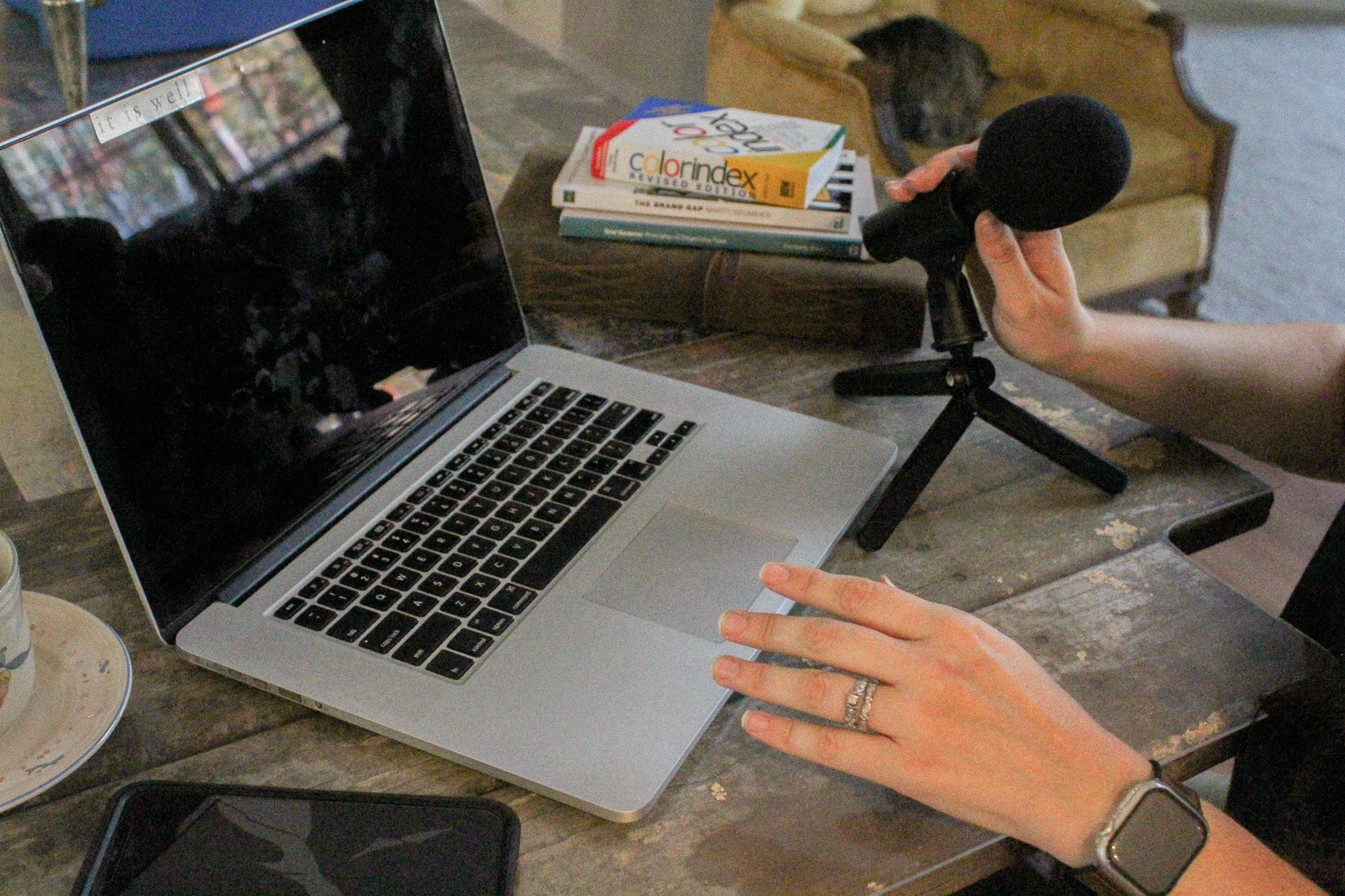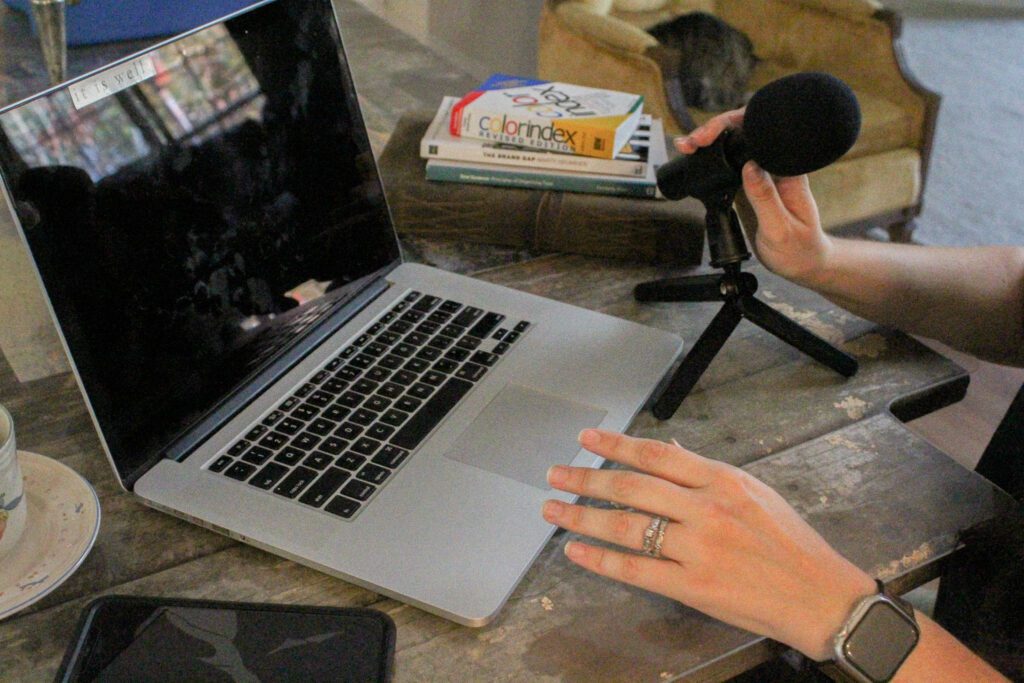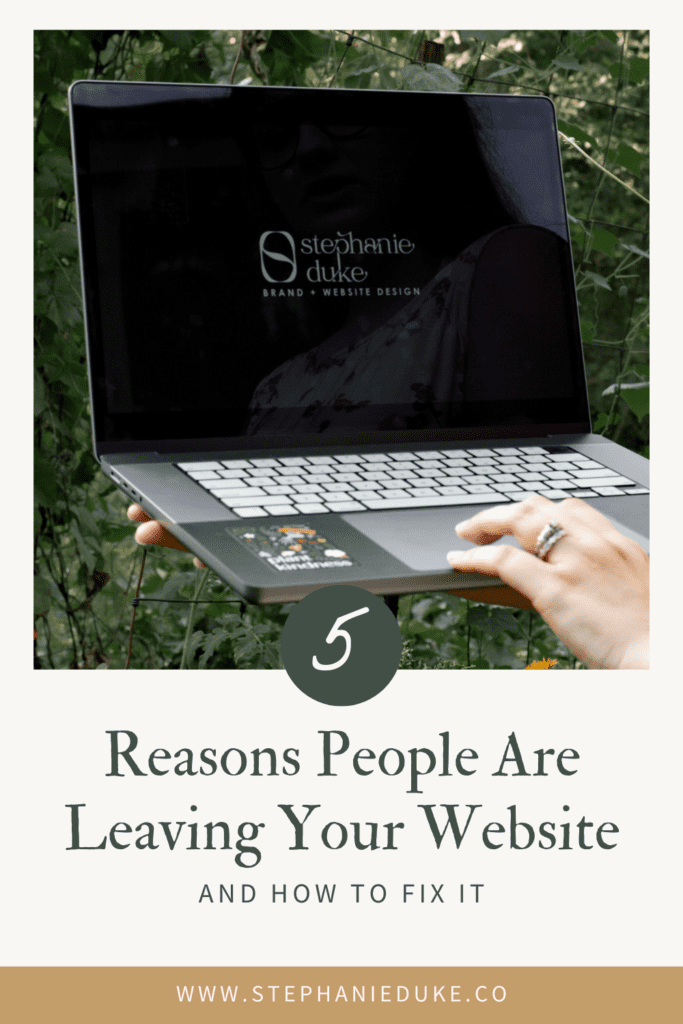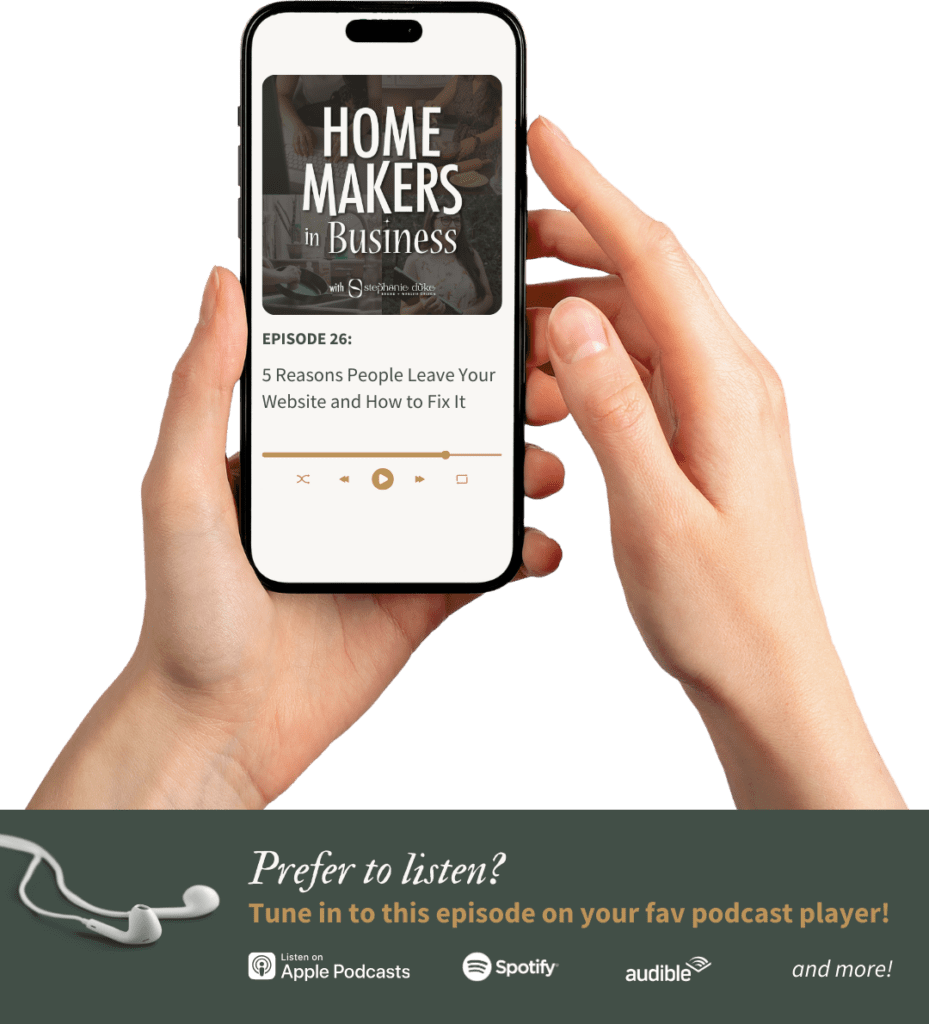5 Reasons People Leave Your Website and How to Fix It


People are more likely to leave a website with bad design, but what exactly constitutes bad website design? Today we’ll be exploring that and how to fix it!
Even if your brand style is not what you would call modern, your website experience should be. If your website doesn’t meet the standards your users expect, they’ll bolt pretty quickly. User experience is the priority, always.
The design is outdated
Website design is not just about aesthetics. It has more to do with functionality now than ever before. And did you know that 42% of people will leave a website due to poor functionality (source)? It’s true. If a user is overwhelmed by the content on a webpage, they’ll quickly click that back button.
There are 3 main factors that may be at play in an outdated website design.
- Flash animations
- Automated music, sounds, or videos
- Overused stock photos
Flash animations
Flash animations were extremely popular in early 2000s website design. It was a multimedia software platform used to play complicated animations, audio, and video on the web. If you’re unfamiliar with it, or just want a kick of nostalgia, examples of “flash websites” can be seen on the Web Design Museum website.
Flash was owned by Adobe, and discontinued in December of 2020. It’s unlikely that you are currently using Flash on your website, but if you are, you can simply uninstall it and begin using modern web design practices.
Automated music, sounds, or videos
Hand in hand with Flash animations, websites that automatically play music, sounds, or videos are utilizing outdated methods from the MySpace era. If music or a video starts blaring from a web page, most users are going to close the tab rather than search for where to turn off the sound. This increases your bounce rate astronomically.
You don’t want your website visitors to instantly be annoyed, confused, or unpleasantly surprised by unexpected sounds. To avoid this, you can simply remove all music and audio files from your website and change video settings to only play when a user clicks the play button.
This isn’t to say you shouldn’t have video on your website, because you absolutely should. Embedding YouTube, Vimeo, or even TikTok videos on your website is great for keeping users on your website longer. This tells search engines like Google that your website is valuable, and therefore your website will rank higher in search results.
Overused stock photos
Stock photos can be a convenient and useful addition to your website. However, many businesses take it so far that they aren’t using any custom photography and are overusing cliche stock photos that every business has access. By cliche, you know what I’m talking about.
The professional handshake. The call center representative. The desk flat lay. The group of overly happy friends.
This type of stock photography is cliche in a bad way, overused, outdated, fake, and inauthentic. It makes your brand look cheap. Luckily, you can avoid this pitfall in a few ways.
- Paid stock photography
- Peruse your camera roll
- Friends and family
- Brand photoshoots
Paid stock photography is an expense, but a worthy one if having more exclusive imagery is important to your brand. Paid stock photography will typically include more diversity, better camera angles, higher-quality editing, and multiple images from the same photoshoot.
If you’re in business, you probably have a smartphone. Which has a camera. With probably thousands of photos on it. You can utilize this as a custom bank of “stock photography” for social media, blog posts, emails, and more. I wouldn’t recommend lower-quality phone photos for your website, but as supplemental photography, it’s a gold mine.
You’re not the only one with a camera roll full of years worth of photos and videos. If you’re looking for a specific composition or subject matter, why not ask your closest friends and family if they’d be willing to share their photos with you? I am not saying to ask anyone and everyone for free photography, especially if they are a professional photographer. Please don’t do that! But your aunt who has a Facebook album for every holiday, vacation, and football game might be generous enough to give you some images to use on your blog.
The best-case scenario would be to have a photo vault full of custom brand photography. With the help of a creative photographer, you can develop a photography bank full of custom storytelling imagery that does a lot of the heavy lifting for you. These photos will be unique to your brand, incorporating your brand colors, and important props, and expressing your unique selling points. Stock photography, paid or not, simply cannot do that.
Your content is not accessible
According to HubSpot, web accessibility is the practice of making websites usable for all visitors, including those with disabilities, impairments, and limitations. Web accessibility involves following certain design principles that ensure that people who experience difficulties or limitations have the same or a similar experience as those who do not. This ensures your content is accessible to every user.
One of my guiding principles as a designer is that clear is kind. This is especially true when it comes to website accessibility. You simply cannot know the limitations a website visitor may have, and the kind thing to do is to prepare your website to meet their needs as well as you can. Thankfully there are loads of tools available to help you make your website more accessible.
A few key areas to consider when assessing your website’s accessibility include:
- Image alt text
- Color contrast
- Video captions
- Form design
Image alt text
Alt text is short for alternative text. This is an important feature for people who are blind or otherwise visually impaired. Alt text allows screen-reading tools to describe the image to the user. It should be descriptive, but to the point and convey the purpose of the image in context to the surrounding content.
Color contrast
There are different types of color contrast to be aware of. For instance, website visitors who are color blind require the contrast to be a certain ratio for small text and large text. There are several tools out there to check color contrast ratios and color blindness accessibility. My current go-to is Adobe Color.
Video captions
Most online video players have an automatic caption feature that users can switch on or off. However, it’s good practice to check your videos before publishing them to your website.
Form design
You may have several embedded forms on your website. Online applications, contact forms, and email marketing signup forms are the most common. These forms need to be designed in a way that are crystal clear to understand and use. Utilize placeholder labels in form fields, write clear instructions, and have error indicators turned on to alert users if a form field is missing.
The navigation structure is unclear
Good website navigation is paramount to a seamless user experience. It helps users find what they’re looking for quickly and easily, keeps them on your site longer, and helps them explore your site fully (source). Good website navigation positively affects user satisfaction, SEO results, and conversion rates.
When we talk about website navigation, we’re primarily talking about menus. You have the main menu typically at the very top of a website, a footer menu at the very bottom, and a hamburger menu for mobile devices.
Here are some tips to create clear navigation menus on your website.
- Keep it simple and be predictable, using clear labels. Do not be cutesy with your wording. For example, use “Blog” instead of “Journal” and “About” instead of “Meet the Artist.”
- Be consistent with your wording, color, and font choices. This is true of every part of your website, but is especially important for navigation menus.
- Nix the “Home” button and simply link your logo to the homepage. This is standard practice.
- Use all 3 main navigation menus. Main, footer, and mobile. Your main menu should contain no more than 8 links. Your footer menu can be a bit more robust, including page links that don’t fit in your main menu. Your mobile navigation should be a collapsible hamburger menu.
- Include a call to action (CTA) in the main navigation. For example, Book Today, Start Your Project, Join Us. This CTA can be more descriptive and engaging than your other navigation links.
- Do not put social icons in your main navigation. You worked hard to get people on your website. Don’t give them a quick out. You can include social icons in your footer menu.
Sources: Mailchimp, Usability Geek, Orbit Media, HubSpot, and NLM.
Your site lacks personality
According to a study done by Adobe, 63% of people worked on their laptops while also watching TV. This means you are fighting to grab and keep people’s attention, even when they’re specifically researching your service or product. I love this analogy from Adobe’s study, “The best chocolate in the world might be passed over if it’s in plain paper wrapping. The same is true with your content and experiences – the design matters more than ever.”
This study concluded that there are 5 main areas for creating content, whether that’s website content or social content, that satisfies consumers. Content must display well, hold attention, appeal to customers’ design sensibilities, personalize their interests, and work across multiple devices.
All of these points focus on one thing. Personalized experience. Consumers want to be catered to, and why shouldn’t they be if you expect them to spend their hard-earned money on your business? This same study found that 59% of global consumers crave beautiful design over simplicity. This doesn’t mean beautiful design can’t ever be simple. It means that design matters. Intention matters. Design builds emotional and loyal connections. Design communicates personality, connection, and authenticity. It’s important. If you don’t offer a good experience, your audience will abandon you.
We can conclude that expressing your brand’s personality through your website isn’t just about using your favorite color. It’s the combo pack of a delightful color palette, readable fonts, emotive imagery, and appropriate graphic elements that are hand-picked for your people. If your brand personality is fun, but your website is just black and white with stock photography and a basic sans-serif font, you’re losing out on connecting with your ideal client.
Your brand’s personality is not about you. It is about connecting with the people that are going to pay your bills. This isn’t to say you can’t begin to build a business with a basic brand identity and website, because you can. But once you are intimately familiar with your ideal client, it is well worth the investment to hire a brand and website designer to get your designs right. It’s easier to maintain brand loyalty from clients when they have an emotional, visceral connection with your brand.
Your site loads too slowly
Website load time is simply how quickly the content of a web page displays. The probability of a user leaving the website increases 32% as page load time goes from 1 second to 3 seconds. The average page speed of a first-page Google result is 1.65 seconds. A majority of consumers say that slow page speeds impact their purchasing decisions. Loading speed is not the only factor that goes into page ranking, but those combined statistics are something to keep in mind as we discuss website loading times.
The overall “weight” of a website is typically what affects load time the most. Internal factors like image and video file size, plugins, and page elements along with external factors such as host response time and network connection all impact page loading time.
What I find typically weighing down my clients’ sites are image file sizes. This is a super easy fix, although possibly time-consuming depending on how many images your website has.
All you need to do is compress your images. This is simply a process that makes the image file size smaller. It will decrease the “weight” of the image while maintaining the highest possible quality. I generally aim for the majority of images to be below 2mg. 1mg is ideal, but I don’t often see a huge difference with the extra megabyte.
There are many image compressor websites out there. Optimizila, Image Resizer, TinyPNG, and Squoosh are all good options. All you have to do is drag and drop the image onto the image compressor website, click compress, then download your compressed image! Rename it for SEO then upload it to your website.
Sources: WishDesk, HubSpot, Blogging Wizard.
What do you do now? Next steps.
There are 2 main fixes I would suggest if your website violates any of these points.
- DIY all the fixes (costs only your time) OR…
- Find a website template that solves your problems. This is time and cost-effective, even if you hire someone to customize the template for you.
If your site is on the smaller, more manageable size, then there’s no reason you couldn’t reasonably fix these issues on your own. Unless you simply didn’t want to do it. However, if your site is more robust, I’d highly recommend a full site refresh with a new website template. This is also something you could do yourself. But if you’re looking to outsource the job, hiring a copywriter to write your website for you and hiring a designer to customize your template is a great choice.
The combined cost of the template, designer, and copywriter will STILL be less costly than a fully custom website alone. And I am not knocking custom websites here! There is a time and place for them. For those that NEED a custom site, they are more than worth the investment.
I just believe that for most small business owners, with the right, strategically designed template you can still get a beautiful high-converting website in a fraction of the time. As a homemaker in business, I know your time is so precious to you.
Tips for finding a quality website template
There are hundreds, if not thousands of website templates out there, just for Showit alone. So how do you know which ones are worth the purchase?
Visual appeal
A website template’s visual appeal is the most obvious factor. But if you have your own brand identity and custom photography, then you should be paying attention to the layout more than the visual elements of a template. Once you purchase a template and go to customize it, the colors, fonts, photos, graphics, and words on the page will be yours and change the “feel” of the template. What you need to pay attention to is the placement of headlines, navigation, images, buttons, and other elements. If the placement of elements on the page is well done, then you can look at more subtle factors like hover effects on buttons, the style of the footer, the shape of buttons, background scrolling effects, gallery types, and others. It can be difficult not to be distracted by the aesthetics of website templates when you’re shopping, but it is important to avoid disappointment in your site after you’ve had it customized.
Responsiveness
When browsing for a website template, scroll the demo site on a laptop, desktop, tablet, and phone if possible to make sure it is responsive across all devices. You don’t want to make the mistake of purchasing a template that is gorgeous on a desktop but has overlapping elements and nonfunctioning buttons on mobile.
Built with SEO in mind
This means choosing a template that is well-organized and optimized for search engines like Google to easily find. All you should have to do is fill in your headlines, meta descriptions, and SEO titles with the keywords you want to rank for.
Pages and functionality
The pages included in a website template are crucial to determining if a template is right for your business. If you’re a creative service provider such as a photographer, designer, event planner, or videographer, then you need a website template with a well-designed portfolio page. If you sell digital products such as courses, then you need a shop page. If you’re a blogger then you need all the blog pages. Think about your specific business, your industry, and your needs, and consider what website pages a template has to have to meet those needs.
Ease of use for you
The template you choose should be easy and intuitive for you to customize. Check out the template creator’s reviews and FAQs for clarity on this.
Scalability
This kind of goes back to pages and functionality. The perfect template for you will either have the exact number and types of pages you need or more. Never less. The hope of owning a business is to grow it over time. This typically means your website is going to grow too. Adding additional pages or sections is as easy as clicking a few buttons in Showit. You can even duplicate existing pages and sections to create new pages with the same layout. Some templates will even come with really robust extra pages like landing page bundles, sales pages, and media kits. You also don’t have to use a page for what it was built for. A template’s About Page can become a Contact Page. All that’s needed is your ingenuity and a little elbow grease.
Customer service and updates
Sometimes things go wrong with a digital product purchase. You want to be confident that the template designer you’re purchasing from will have your back if you need help with a misplaced email or technical issue with the template design. Check out their customer service policies and reviews to know what to expect.
With all of those factors in mind, my favorite go-to Showit website template shop is EM Shop by Elizabeth McCravy. Her template designs check all of the boxes for finding a quality website template. Her designs are timeless, easily customizable, built with SEO in mind, and highly functional – meaning I’ve never run into a backend tech issue customizing one of her templates!
Every EM Shop template also comes with a comprehensive training called the Showit Blueprint Course which includes additional tools and resources. I can personally vouch for everything Elizabeth creates as I’ve been a member of her Booked Out Designer course and Breakthrough Brand All-Access membership, as well as purchased one of her templates to add to my website. Yeah, even website designers use templates sometimes!
To recap, some of the top reasons people leave your website are the design is outdated, your content is not accessible, the navigation structure is unclear, your site lacks personality, and your site loads too slowly. If your website is guilty of any of these, I’d suggest making a plan to DIY the fixes on your existing website or purchasing a strategically built website template that sets you up for success.
If you have any questions about fixing your website, don’t hesitate to DM me on Instagram or send me an email at hello@stephanieduke.co. I’m happy to help you navigate the process. And if you’re ready to invest in a website template and want a designer to customize it for you, I’m your gal! Showit website template customizations are some of my favorite projects to do as a VIP Design Day. All you have to do is give me your copy, photos, and other content in advance and I’ll have your website ready to go in a single day. It’s a super simple and fun process.
By the way, if you’re not already subscribed to the Homemaker’s in Business Weekly Bulletin, might I suggest doing that now? I sent the first edition last week and got some great responses!
Asha said, “The newsletter is amazing. It is everything my girlie empath ADHD brain wants. I want to know more about you and the recipes you make while still slipping in great content for my business. More please!”
Mara said, “I love this email (click the link to read the first issue) so much! It’s such a good mix of just life and biz advice!”
Since podcasting and blogging are one-sided, I’d love to see you in my email community and get to know you more.

RESOURCES:
- Looking for a strategic, gorgeous Showit website template? Look no further than EM Shop 💻
- Book a VIP Design Day to get your EM Shop template customized in a day.
- Are you a designer? Join Elizabeth McCravy’s Booked Out Designer course! This is the course I took that allowed me to quit my last part-time job and go full-time in my design business.
- Get a month of Showit for FREE in addition to their 14-day free trial – a total of 44 free days! Use code stephdukeshowit
- Flodesk makes creating beautiful newsletters easy and fun. Get 50% off your first year with my link.
WANNA BE A GUEST ON THE SHOW?
- Click here to fill out the application if you want to be a guest on the podcast or have a guest suggestion.
- Interviewing guests on your own podcast? You should be using Riverside! MagicClips makes creating social media promotional content a breeze.
WORK WITH STEPHANIE:
- VIP Design Day
- Brand Identity Design
- Showit Website Design
- Schedule a free 30-min consult call OR fill out my contact form
CONNECT WITH STEPHANIE:
stephanieduke.co | Instagram | Facebook | Pinterest | Buy Me a Coffee
Thanks for tuning in to the Homemakers in Business Podcast! If you enjoyed this episode, please:
- Share a screenshot with your fav parts to your IG story and tag me @stephanieduke.co
- Sign up for additional resources and insider updates! I send this email once a week and it is PACKED full of value for improving your brand, website, and marketing! Get on the list here. Mara says, “I love this email so much! It’s such a good mix of just life and biz advice!”
- Follow the podcast and leave a 5-star rating and review on Apple Podcasts.
I’m Stephanie, but you can call me Steph!
I design brands & websites that get you butterflies-in-your-stomach-excited about your business again.
Simply put, I’m a graphic designer that specializes in brand identity design and Showit website design - arguably the most important aspects of your business! I live in central Alabama with my high school band directing hubby, Thomas, on our modest homestead in the country.
your guide to a stress-free website
FREE Website Planning Tool
- My exact Website Copy Planner Google Doc
- A master doc for keeping track of links and embed codes
- Loads of tips and tricks for planning website content (copy, photos, branding, etc) with ease
